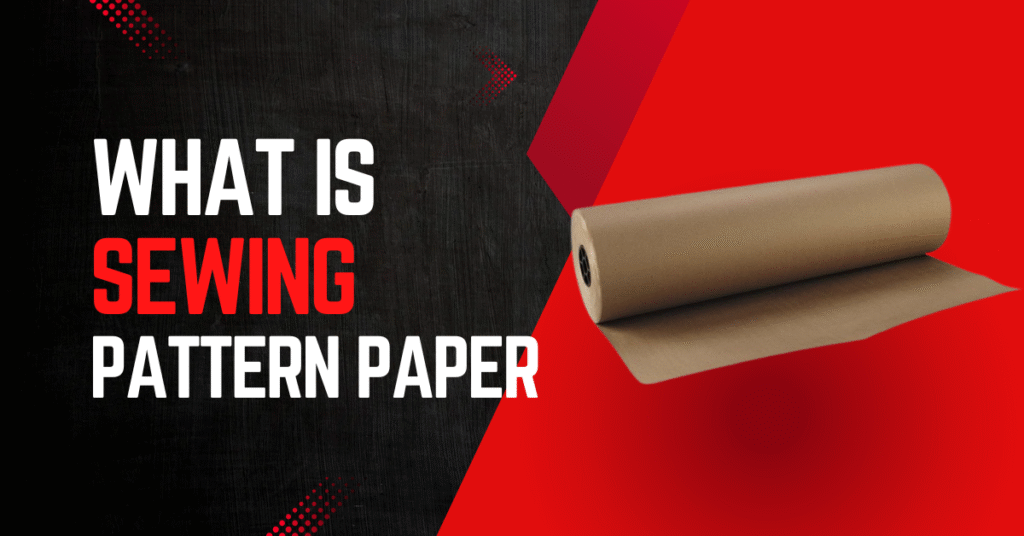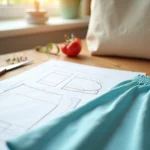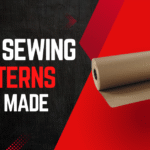A sewing pattern paper is a durable paper used to draft, trace, and adjust garment patterns. This paper is resists tearing, supports alterations like FBAs, and offers better longevity than standard paper for professional or home use. It includes materials like medical exam paper, manila paper, and oaktag.
What Is a Sewing Pattern?
A sewing pattern is a template which you’ll find online or buy from Amazon. Usually a sewing patterns are made of paper. It include various pieces drawn flat, representing parts of the garment such as front, back, sleeves, and collars.
It’s actually a blueprint or guide that lays out the shapes you’ll need to cut from fabric to assemble a garment or accessory. These patterns indicate crucial details, like seams, darts, pleats, and allowances, guiding you through the construction process.
Some patterns come with intricate markings and adjustments for fit, making them a must-have for tailoring projects. Sewing pattern paper plays a vital role in making, preserving, and working with these patterns.
Types of Paper Used for Sewing Patterns
There are 8 types of sewing pattern paper used. These are:
1. Tissue Paper
Tissue paper isn’t just for gifts—in sewing, it serves multiple purposes. It helps when working with difficult fabrics like oilcloth and vinyl by creating a slippery barrier that prevents sticking on the presser foot. It also provides stability for thinner fabrics such as silk that tend to slide during stitching. As a result, knits are protected from picking, running, and other damage during the sewing process.
2. Swedish Tracing Paper
This remarkable material feels more like fabric than paper, making it uniquely versatile. Strong enough to be sewn into a muslin, Swedish Tracing Paper allows you to trace, cut, and even baste pieces together to check fit before cutting your good fabric. Available in 29″ wide, 10-yard rolls, it’s slightly more expensive at about $1.58 per meter. Despite the cost, its durability and fabric-like qualities make it worth considering for serious sewists.
3. Medical Exam Paper
This popular cost-effective option comes in rolls typically 21″ wide. At prices ranging from 14 cents per yard to less than $0.05 per yard when purchased in bulk (900 yards for $49.09), it’s remarkably economical. Although it wrinkles and tears more easily than other options, it’s perfectly see-through, making it ideal for tracing commercial patterns.
4. Freezer Paper
Found in most grocery stores, freezer paper has a unique feature—one side has a plastic coating that temporarily adheres to fabric when ironed. This makes it excellent for creating templates that stay in place without pins. Simply iron the shiny side down onto your fabric, trace or cut around it, then peel it away. It’s particularly useful for quilting and appliqué work.
5. Dot Paper
Also known as marking paper, alphabet paper, or alphanumeric paper, dot paper features a grid of small blue letters, numbers, or markers at one-inch intervals. This gridded system allows for accurate pattern making and alterations. Slightly heavier than tissue paper yet thin enough to see through, dot paper accepts pencil marks that erase easily.
6. Brown Craft Paper
At 40# thickness (about .004 inches), brown craft paper is slightly thinner than paper grocery bags but more flexible. Available in widths from 48″ to 66″ and in rolls of 800 feet, it’s ideal for creating durable patterns that will be used frequently. Though not transparent, its stiffness makes it excellent for tracing existing garments.
7. Bonded Textiles
These 100% polypropylene fabrics are dimensionally stable and stiff, making them perfect for pattern making. Similar to non-woven, non-fusible lightweight interfacing, bonded textiles claim not to tear and are sewable. This allows you to trace a pattern, cut it out, baste the pieces together, and check the fit before cutting your good fabric.
8. Oak Tag
Used in professional sample rooms and by high-end companies, oak tag (also called tagboard or manila pattern paper) is the heavyweight champion of pattern papers. It’s ideal for creating slopers (basic fit templates) and for patterns you’ll use repeatedly. Its durability means you can trace around it onto fabric using chalk, then cut directly without the pattern getting in the way.
How to Choose the Best One
Selecting the ideal sewing pattern paper involves balancing several factors. Throughout my years of sewing, I’ve discovered that making the right choice depends on your specific circumstances.
Consider your sewing skill level
Your experience directly impacts which pattern paper works best for you. Beginners often benefit from sturdier papers that won’t tear easily during frequent handling. If you’re new to sewing, look for patterns labeled “Easy” or “Beginner” that teach foundational techniques like straight seams, curved seams, and simple shaping methods. For novices, dot paper with its helpful grid lines offers excellent guidance through the pattern-making process.
Intermediate sewers tackling more precision-oriented projects might prefer Swedish tracing paper or medical exam paper that allow for accurate adjustments. Advanced sewers creating tailored pieces with elevated details like bound buttonholes often require oak tag or heavyweight papers that withstand repeated use.
Match paper type to fabric and project
Accordingly, different fabrics call for different pattern papers. Lightweight fabrics pair well with transparent papers that let you see prints and patterns underneath. For heavy materials like denim or leather, sturdier papers prevent shifting during cutting.
Complex projects with multiple pieces benefit from papers that accept clear markings and allow for precise adjustments. Conversely, simple projects might only require basic tracing paper or even repurposed wrapping paper.
Durability vs. transparency
Finding balance between these qualities is essential. Transparent papers like medical exam paper excel at pattern tracing but may tear easily. Meanwhile, kraft paper offers durability for repeated use yet sacrifices some visibility.
Swedish tracing paper represents an excellent middle ground—durable enough to withstand multiple uses while remaining transparent enough for tracing. Consider whether you’ll use the pattern once or repeatedly before deciding which quality matters most.
Budget and availability
Finally, cost considerations cannot be overlooked. Medical exam paper provides exceptional value at approximately 14 cents per yard. Conversely, professional-grade oak tag offers premium durability at higher prices.
Beyond price, consider storage space. Some papers fold flat for envelope storage while others require rolling or hanging. Your available storage will influence which option works best in your sewing space.
Tips for Using and Storing Pattern Paper
Practical knowledge about handling and organizing pattern paper can make your sewing experience more enjoyable. Here’s how to manage your patterns effectively.
How to trace patterns correctly
Preserving your original patterns starts with proper tracing techniques. First, lay your pattern on a flat surface and place tracing paper over it, securing with weights rather than pins to prevent shifting. Use colored pencils since they’re less likely to tear delicate paper. For accuracy, begin by marking corners and every few centimeters on curves, subsequently connecting them with straight lines using a ruler. Remember to transfer all important markings like notches, darts, and grainlines.
Preserving original patterns
Extending the life of your patterns requires thoughtful handling. Instead of cutting directly into originals, trace onto suitable material like Swedish tracing paper or Pellon 830 interfacing. For vintage patterns or frequently used designs, consider transferring them to patterning fabric which doesn’t fray and can be pressed. Furthermore, you can create cardboard templates of your favorite patterns, allowing you to simply trace around them with chalk or a washable pen.
Folding vs. rolling for storage
Each storage method offers distinct advantages. Rolling works particularly well for uncut patterns—secure with rubber bands and store upright in tubes, laundry bins, or tall baskets. Alternatively, folding patterns allows them to fit in binders, envelopes, or file folders. Should your folded patterns develop creases, gently press them with an iron on low heat (no steam).
Labeling and organizing your patterns
Effective organization begins with thorough labeling. Include pattern company, name/number, piece description, size, and any modifications you’ve made. Consider organizing by garment type, complexity level, or season. For quick reference, use color-coded labels on storage containers. Keep patterns in cool, dry places away from direct sunlight and humidity. Lastly, store patterns with notes about fit adjustments, fabric recommendations, or future hack ideas.
Conclusion
Pattern paper stands as an essential foundation for successful sewing projects. Throughout this guide, we’ve explored what pattern paper actually is, the various types available, and how to select the perfect option for your specific needs. Undoubtedly, choosing the right pattern paper dramatically impacts your sewing experience and final results.
When I first began sewing, understanding pattern paper fundamentals transformed my projects from frustrating struggles to satisfying creations. Therefore, I encourage beginners to take time exploring different options rather than grabbing whatever paper is handy. Swedish tracing paper might work perfectly for one project, while medical exam paper proves ideal for another.
Additionally, proper storage and handling techniques extend the life of your patterns, making them valuable resources for years to come. Whether you choose to roll, fold, or create durable templates depends largely on your space limitations and how frequently you use each pattern.


